MG 42
From Wikipedia, the free encyclopedia
|
|
This article needs additional citations for verification. (August 2008) |
| MG 42 | |
|---|---|
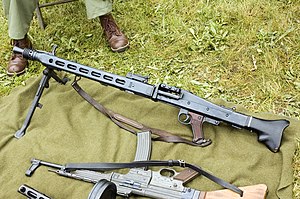 MG 42 (top) |
|
| Type | General-purpose machine gun |
| Place of origin | |
| Service history | |
| In service | 1942-1968 |
| Wars | World War II, Portuguese Colonial War[1] |
| Production history | |
| Designed | 1942-1959 |
| Manufacturer | Mauser Werke AG Wilhelm-Gustloff-Stiftung Steyr-Daimler-Puch, Großfuß AG, MAGET (Maschinenbau und Gerätebau GmbH, Berlin-Tegel) |
| Produced | 1942–1945 (Nazi Germany) |
| Number built | 400,000+ |
| Variants | MG 45/MG 42V, MG 1, MG 2, Rheinmetall MG 3, M53, MG 74 |
| Specifications | |
| Weight | 11.57 kg (25.51 lb) |
| Length | 1,120 mm (44 in) |
| Barrel length | 533 mm (21.0 in) |
|
|
|
| Cartridge | 7.92×57mm Mauser |
| Action | Recoil-operated, roller-locked |
| Rate of fire | 1,200 rounds/min (varied between 900–1,500 rounds/min with different bolts) |
| Muzzle velocity | 755 m/s (2,477 ft/s) |
| Effective range | 1000 m |
| Feed system | 50 or 250-round belt |
The MG 42 has a proven record of reliability, durability, simplicity, and ease of operation, but is most notable for its ability to produce a stunning volume of suppressive fire. The MG 42 has one of the highest average rates of fire of any single-barreled man-portable machine gun: between 1,200 and 1,500 rpm, which results in a distinctive muzzle report. There were other automatic weapon designs with similar firepower, such as the French Darne, the Hungarian-Gebauer single-barreled tank MGs, the Russian 7.62mm ShKAS aircraft gun and the British Vickers K machine gun. However, the MG 42's belt-feed and quick-change barrel system allowed for more prolonged firing in comparison to these weapons.
The MG 42's lineage continued past Nazi Germany's defeat, forming the basis for the nearly identical MG1 (MG 42/59), and subsequently evolving into the MG1A3, which was in turn followed by the MG 3. It also spawned the Swiss MG 51, SIG MG 710-3, Austrian MG 74, and the Spanish 5.56mm Ameli light machine gun, and lent many design elements to the American M60 and Belgian MAG. The MG 42 was adopted by a number of armed organizations after the war, and was both copied and built under licence.
Contents[hide] |
[edit] History
[edit] Development
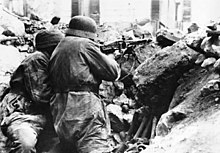
Fallschirmjäger
defend the ruins of Monte
Cassino. Well entrenched, the Germans inflicted heavy casualties on
the assaulting Allied forces.
In order to address these issues, a contest was held for a true MG 34 replacement. Three companies were asked to submit designs: Metall und Lackierwarenfabrik Johannes Großfuß AG of Döbeln, Rheinmetall-Borsig of Sömmerda, and Stübgen of Erfurt.[3] Of the number of proposals submitted, Großfuß AG's proved to be the best design by far, employing a unique recoil-operated roller locking mechanism whereas the two competing designs used a gas-actuated system.[3] Interestingly, the company had no prior experience in weapons manufacture, specializing in pressed and stamped steel parts (the company's staple product was sheet metal lanterns).[3] Ernst Grunow, one of the leading design engineers with Großfuß, knew nothing about machine guns when he was given the task of being involved with the project, but he specialized in the technology of mass production. Grunow would attend an army machine gunner's course to familiarize himself with the utility and characteristics of such a weapon, also seeking input from soldiers. He then recycled an existing Mauser-developed operating system and incorporated features from his experiences with army machine gunners and lessons learned during the early stages of the war.[3] The new design required considerably less tooling and was much simpler to build—it took 75 man hours to complete the new gun as opposed to 150 man hours for the MG 34 (a 50% reduction), and cost 250 RM as opposed to 327 RM (a 24% reduction). The MG 42 was made out of stamped metal, making it much easier to produce than other machine guns.
The resulting MG 39 remained similar to the earlier MG 34 overall, a deliberate decision made to maintain familiarity. The only major changes from the gunner's perspective were dropping of most of the drum-feed options, leaving the weapon to fire with a loose belt of ammunition or from a single 50-round drum shaped belt container fitted to the gun's receiver, and simplifying the weapon's open sights for aiming purposes; all these changes being intended to increase, maintain, or accommodate the gun's high practical rate of fire. Although made of relatively cheap parts, the prototypes also proved to be considerably more rugged and resistant to jamming than the somewhat temperamental MG 34. A limited run of about 1,500 of its immediate predecessor, the MG 39/41, was completed in 1941 and tested in combat trials.
The weapon was officially accepted, and the main manufacturing of the production design began in 1942, as the MG 42. contracts going to Großfuß, Mauser-Werke, Gustloff-Werke, and others. Production during the war amounted to over 400,000 units (17,915 units in 1942, 116,725 in 1943, 211,806 in 1944, and 61,877 in 1945).
[edit] Service history
One of the weapon's most notable features was its comparatively high rate of fire of about 1,200 rounds per minute, twice the rate of the British Vickers machine gun and American Browning at 600 round/min. So distinct and terrifying was the weapon that the United States Army created training films to aid its soldiers in dealing with the psychological trauma of facing the weapon in battle.[4] At such a high rate the human ear cannot easily discern the sound of individual bullets being fired, and in use the gun makes a sound described as like "ripping cloth" and giving rise to the nickname "Hitler's buzzsaw", or, more coarsely, "Hitler's zipper" (Soviet soldiers called it the "linoleum ripper"). German soldiers called it Hitlersäge ("Hitler's saw") or "Bonesaw". The gun was sometimes called "Spandau" by British troops from the manufacturer's plates noting the district of Berlin where some were produced, much like the Germans' own World War I MG 08 had been nicknamed. Notwithstanding the MG 42's high rate of fire, the Handbook of the German Army (1940) forbade the firing of more than 250 rounds in a single burst and indicated a sustained rate of no more than 300–350 rounds per minute to minimize barrel wear and overheating.The high rate of fire resulted from experiments with preceding weapons that concluded that since a soldier only has a short period of time to shoot at an enemy, it was imperative to fire the highest number of bullets possible to increase the likelihood of a hit. This principle was also behind the Vickers GO aircraft gun. The disadvantage of applying this principle was that the weapon consumed exorbitant amounts of ammunition and quickly overheated its barrel, making sustained fire problematic.
The method of barrel change made the MG 42 unsuitable for secondary or co-axial armament on World War II era German tanks with the exception of the Jagdpanzer IV. Early versions of the Jagdpanzer IV carried two standard (no modification made) MG 42's on both sides of the gun mantlet/glacis, firing through a ball slot which was protected by an armored cover (with the MG 42 retracted) when not in use. Later version Jagdpanzer IV's carried only one MG 42 on the left side.
In the German Heavy Machine Gun (HMG) Platoon, each Platoon served four MG 34/MG 42 machine guns, used in the sustained fire mode mounted on tripods. In 1944 this was altered to six machine guns in three sections with two 7 man heavy machine gun squads per section.
Heavy Machine Gun Squad
- Squad Leader (NCO) MP40
- Machine Gunner (Private) MG 34/MG 42 and Pistol
- Assistant Gunner (Private) Pistol
- Three Riflemen (Privates) Rifles
- Horse leader for Horse, cart and trailer (Private) Rifle
[edit] Operation
The MG 42 weighed 11.6 kg in the light role with the bipod, lighter than the MG 34 and easily portable. The bipod, the same one used on the MG 34, could be mounted to the front or the center of the gun depending on where it was being used. For sustained fire use, it was matched to the newly developed Lafette 42 tripod, which weighed 20.5 kg on its own. The barrel had polygonal rifling and was lighter than the MG 34's and heated more quickly, but could be replaced in seconds by an experienced gunner.The optimum operating crew of an MG 42 for sustained fire operation was six men: the gun commander, the No.1 who carried and fired the gun, the No.2 who carried the tripod, and Nos.3, 4, and 5 who carried ammunition, spare barrels, entrenching tools, and other items. For additional protection the commander, No.1 and No.2 were armed with pistols, while the remaining three carried rifles. This large team was often reduced to just three: the gunner, the loader (also barrel carrier), and the spotter. The gunner of the weapon was preferably a junior non-commissioned officer (or Unteroffizier).
U.S. and British doctrine of the era centered around the rifleman, with the machine gun serving a support role. German doctrine was the reverse, with the machine gun placed in a central role and rifleman employed in support. This meant that German forces deployed far more machine guns per equivalent-sized unit than the allies, and that allied troops assaulting a German position almost invariably faced the firepower of the MG42. It was possible for operating crews to lay down a non-stop barrage of fire, ceasing only when the barrel had to be replaced. This allowed the MG 42 to tie up significantly larger numbers of enemy troops. Both the Americans and the British trained their troops to take cover from the fire of an MG 42, and assault the position during the small window of barrel replacement. The high rate of fire of the MG 42 sometimes proved a liability, mainly in that, while the weapon could be used to devastating effect, it could quickly exhaust its ammunition supply. For this reason, it was not uncommon for all soldiers operating near an MG 42 to carry extra ammunition, thus providing the MG 42 with a backup source when its main supply was exhausted.
[edit] Design details
The MG 42 is roller-locked and recoil-operated (short recoil) with gas assist. It fires belt fed 7.92mm ammunition from an open bolt.The roller-locked bolt assembly consists of a bolt head, two rollers, a striker sleeve, bolt body, and a large return spring, which is responsible for pushing the bolt assembly into battery (the locked position) and returning it there when it is unlocked and pushed backwards by the recoil of firing or by the charging handle. As the striker sleeve is movable back and forth within the bolt assembly, the return spring is also responsible for pushing the striker sleeve forward during locking (described below). The bolt assembly locks with the barrel's breech (the end the cartridge is loaded into) via a prong type barrel extension behind the breech. As it is recoil-operated and fired from an open bolt, the weapon must be manually charged with the side-mounted charging handle.
The roller-locked recoil operation functions as follows: two cylindrical rollers, positioned in tracks on the bolt head, are pushed outwards into matching tracks in the barrel extension by the striker sleeve and lock the bolt in place against the breech. Upon firing, rearward force from the recoil of the cartridge ignition pushes the striker assembly back and allows the rollers to move inwards, back to their previous position, unlocking the bolt head and allowing the bolt assembly to recoil, extracting the spent cartridge and ejecting it. The return spring then pushes the bolt assembly forwards again, pushing a new cartridge out of the belt into the breech, and the sequence repeats as long as the trigger is depressed. The MG42 is only capable of fully automatic fire. Single shots are exceptionally difficult, even for experienced operators, due to the weapon's rate of fire. The usual training objective is to be able to fire a burst of no more than three rounds. The weapon features a recoil booster at the muzzle to increase rearwards force due to recoil, therefore improving functional reliability and rate of fire.
The MG 42 fires from an open bolt, meaning the bolt (not just the firing pin) is held in a rearward position when the trigger is not depressed. Depressing the trigger releases the bolt assembly, of which the firing pin is a component.
The shoulder stock is designed to permit gripping with the left hand to hold it secure against the shoulder. Considerable recoil otherwise causes the stock to creep from its intended position. If the weapon is not properly "seated" on the bipod, a prone gunner may be pushed back along the ground from the high recoil of this weapon.
The MG 42 barrel shroud houses a quick barrel change device similar to the Thompson Light Rifle.[5]
The sighting line consists of a ∧-type post or an inverted "V" height adjustable front sight on a folding post and a leaf rear sight with an open V notch sliding on a ramp, graduated from 200 to 2,000 meters (219 to 2,187 yards). There is an antiaircraft rear peep sight hinged on the open rear sight base. An auxiliary antiaircraft ring sight is kept in the maintenance kit, and fitting on the barrel jacket to be used in conjunction with the folding antiaircraft rear peep sight attached to the rear sight base.
[edit] Variants and developments
[edit] MG45
In 1944, the material shortages of the Third Reich led to the development of a newer version, the MG 45 (or MG 42V), which had a different operation mechanism that used delayed blowback as opposed to roller locking. For this reason, the MG 45 is considered a different type of firearm, as the mechanisms of these two guns are different. It used steel of lesser quality, which reduced weight to 9 kg, while retaining the horizontal cocking handle. First tests were undertaken in June 1944, but development dragged on and eventually only ten were built. The tested MG 45/42V fired 120,000 rounds in succession at a rate of fire around 1,350 rounds per minute. The MG 42V had some influence in the post-war development of roller-delayed blowback system, as employed in modern Heckler & Koch small arms.[edit] T24 machine gun
The American military tried to copy the MG42 during the war as a possible replacement for the Browning Automatic Rifle & M1919A4 for infantry squads, the new version being adapted for the .30-06 cartridge. Saginaw Steering Gear constructed a working prototype designated as the T24 machine gun which could also be used on an M2 Tripod. However, the realization that the .30-06 cartridge might be too long for the gun's mechanism to easily cope with, and most notably a design flaw in the prototype, resulted in the discarding of the project.[6][edit] M53
Yugoslavia license-built the MG 42 at the state-owned Zavodi Crvena Zastava company as the M53 machine gun, retaining the 7.92×57mm Mauser caliber.[7] By doing so, the Yugoslavians retained the original weapon's design features, making the M53 a nearly exact copy of the German MG 42. The only major difference is a slower rate of fire.[8] The aiming range of the M53 is 2000 meters, and the terminal range of the bullet is 5000 meters, the same as the MG 42. MG 42s captured in Yugoslavia at the end of World War II were put into reserve of Yugoslav People's Army as M53/42s. The last military use of M53s in Yugoslavia was in 1999. Some quantities of M53s were exported to Iraq in the 1980s and saw extensive action during both Gulf wars.[9] M53 was known under nickname Šarac.[edit] MG3
The MG 42, with small modifications, resulted in the Beretta MG 42/59—still used by the Italian Army—and Rheinmetall MG 3, which is the primary general-purpose machine gun of the modern German armed forces (Bundeswehr). A number of other armies around the world have adopted versions of the original, especially the MG3, and it remains in widespread service today. Its belt-feed mechanism was copied and used in the design of the M60 machine gun. The T161 beat the FG 42-derived T52 during tests in the 1950s to become the M60. The T161 used a different gas system and was easier to make than the T52, but they both used a similar belt-feed and basic configuration. The trigger mechanism of the FN MAG or MAG-58 is a virtual copy of the MG 42's and the MAG-58's belt-feed is also very similar.- Rate of fire: Variable, from 900 rounds/min to 1,500 round/min or more depending on installed bolt weight (different weight bolt components introduced to regulate rate of fire, lighter assemblies providing faster rates of fire). Throat erosion and component wear also introduced significant variation. Up to 1,800 round/min on the MG 45 or without "recoil booster" (Rückstoßverstärker).
- Parts changes:
- Barrel: 3 to 7 seconds[citation needed]
- Barrel and lock: 25 to 30 seconds[citation needed]
[edit] MG 74
The final variant to date is the MG 74, developed by Austria and since 1974 it is the standard machine gun of the Austrian Armed Forces.After its founding in 1955, the Austrian army was equipped with old guns temporarily out of U.S. stocks. Starting in 1959 these Browning M1919 were largely replaced by the MG 42 with modified barrel and bolt for the new 7.62mm NATO caliber. But to introduce a modern weapon of its own production the Office of Defence Technology, in cooperation with Steyr Mannlicher and Beretta developed a gun specifically for the Austrian Army. The German MG 42/59 that was introduced in 1959 with the Bundeswehr to replace the U.S. machine-guns, served as the basis, which was similar to the Austrian 7.62 mm MG 42. Targets were to reduce, among other things, the rate of fire and weight and have more versatile sights and mount. The development of the weapon was completed in 1974. It replaced from this year the MG 42 as the MG 74 of the Austrian Federal Army.
The modifications to the basic MG 42 design include an extremely heavy bolt (950 grams vs. the 675 gram MG 3 bolt) which reduces the rate of fire to around 850 rounds per minute. Rate of fire can be varied, if necessary, by changing the shutter. In addition, a select fire trigger group was added to allow semi-automatic fire (single shot) compared to the traditional fully automatic only fire capability of the original MG 42 design. The MG 74 also has a modern polymer stock and handgrips to save weight. Usually colored a dark green, adjustable rear sight (35° horizontal, vertical 15°) and additional anti-aircraft sight can be mounted optional.
MP 40
From Wikipedia, the free encyclopedia
"MP36" and "MP40" redirect here. For the
MP36PH and MP40PH passenger locomotive, see MPI
MPXpress.
| Maschinenpistole 40 | |
|---|---|
 MP 40/I (stock extended) |
|
| Type | Submachine gun |
| Place of origin | |
| Service history | |
| In service | 1939–Present |
| Used by | See Users |
| Wars | World War II, Cold War (Limited)[1] |
| Production history | |
| Designer | Heinrich Vollmer [2] |
| Designed | 1938 |
| Manufacturer | Erma Werke |
| Produced | 1940–1945 |
| Number built | Approx. 1 million |
| Variants | MP 36, MP 38, MP 40, MP 40/1, MP 41 |
| Specifications | |
| Weight | 4 kg (8.82 lb) |
| Length | 833 mm (32.8 in) stock extended / 630 mm (24.8 in) stock folded |
| Barrel length | 251 mm (9.9 in) |
| Cartridge | 9x19mm Parabellum |
| Action | Straight blowback, open bolt |
| Rate of fire | 500 rounds/min |
| Muzzle velocity | ~380 m/s (1,247 ft/s) |
| Effective range | 70 m[3]-100 m[1] |
| Feed system | 32-round detachable box magazine 64-round with dual magazines |
| Sights | Hooded front blade, fixed and flip-up U-notch rear |
Contents[hide] |
[edit] Development
The MP 40 was often called the "Schmeisser" by the Allies, after weapons designer Hugo Schmeisser. Schmeisser had designed the MP 18, which was the first mass-produced submachine gun, and saw extensive service at the end of the First World War. He did not, however, design the MP 40,[5] although he held a patent on the magazine. He later designed the MP 41, which was an MP 40 with a wooden rifle stock and a selector, identical to those found on the earlier MP 28 submachine gun. The MP 41 was not introduced as a service weapon with the German Army, but saw limited use with some SS and police units. They were also exported to Germany's ally, Romania. The MP 41's production run was brief, as Erma filed a successful patent infringement lawsuit against Schmeisser's employer, Haenel.
Despite the impression given by popular culture, particularly in war films and video games, MP 40s were generally issued only to paratroopers and platoon and squad leaders;[citation needed] the majority of German soldiers carried Karabiner 98k rifles. However, later experience with Soviet tactics - such as the Battle of Stalingrad where entire units armed with submachine guns outgunned their German counterparts in short range urban combat - caused a shift in tactics, and by the end of the war the MP 40 and its derivatives were being issued to entire assault platoons on a limited basis.
There were never enough MP 40s to go around, because raw material and labor costs made it expensive to produce alongside the Kar98 rifles. Starting in 1943, the German army moved to replace both the Kar-98k rifle and MP 40 with the new MP 43/44 assault rifle, also known later as the StG 44.
[edit] Design
The MP 38 receiver was made of machined steel, but this was a time-consuming and expensive process. To save time and materials, and thus increase production, construction of the MP 40 receiver was simplified by using stamped steel and electro-spot welding as much as possible. The MP 38 also features longitudinal grooving on the receiver and bolt, as well as a circular opening on the magazine housing. These features were eliminated on the M38/40 and MP 40.
One unique feature found on on most MP 38 and MP 40 submachine guns was an aluminum, steel, or bakelite resting bar or support under the barrel. This was used to steady the weapon when firing over the side of open-top armored personnel carriers such as the Sdkfz 251 half-track. A handguard, made of a synthetic material derived from bakelite, was located between the magazine housing and the pistol grip. The barrel lacked any form of insulation, which often resulted in burns on the supporting hand if it was incorrectly positioned. The MP 38 and MP 40 also had a forward-folding metal stock, the first for a submachine gun,[7] resulting in a shorter overall weapon when folded; however, this stock design was at times insufficiently durable for hard combat use.
Although the MP 40 was generally reliable, a major weakness was its 32-round magazine. Unlike the double-column, dual-feed magazine insert found on the Thompson M1921-28 variants, the MP 38 and MP 40 used a double-column, single-feed insert. The single-feed insert resulted in increased friction against the remaining cartridges moving upwards towards the feed lips, occasionally resulting in feed failures; this problem was exacerbated by the presence of dirt or other debris.[8] Another problem was that the magazine was also sometimes misused as a handhold. This could cause the weapon to malfunction when hand pressure on the magazine body caused the magazine lips to move out of the line of feed, since the magazine well did not keep the magazine firmly locked. German soldiers were trained to grasp either the handhold on the underside of the weapon or the magazine housing with the supporting hand to avoid feed malfunctions.[9][10]
[edit] Copies and post-war usage
After the end of World War II, many MP 40s captured by the Allies were redistributed to the paramilitary and irregular forces of some developing countries; these guns were eventually used in conflicts in Greece, Israel, and Vietnam.[1]The MP 38 or MP 40 was also a pattern for diverse submachine guns such as:
- While designing the American .45-caliber M3 submachine gun, engineers considered some features of the British Sten guns and captured MP 40s. The M3 used a copy of the Sten magazine, which itself was similar to the MP 40 magazine.
- The Spanish company Star Bonifacio Echeverria, S.A. produced the Star Modelo Z-45, a variant of the MP 40.[11] Produced in 9x23mm Largo, the Z-45 is a selective-fire submachine gun, equipped with either a wooden or a folding metal buttstock, and wooden handguards.[12] Its magazine was a copy of the MP 40, and held 30 rounds.[12] It served in Spain, Cuba, Chile, Portugal and Saudi Arabia and was used for the first time in combat in the battle of Sidi Ifni.
- The Yugoslav Peoples Army used a similar submachine gun in 7.62x25mm Tokarev produced by Zastava called the M56 which was used in some quantity in the various conflicts after the breakup of Yugoslavia. It was recognized by its long thin barrel, curved magazines, and a permanently mounted folding bayonet.
- The Norwegian Army used the MP 40 from 1945 until about 1970[13] and other parts of the Norwegian armed forces, such as the Norwegian Home Guard, still issued the MP 40 up into the early 1990s.
- Some MP 40s were in use by the Kosovo Liberation Army in the Kosovo War in 1999.[14]
- Two MP 40s were used by the LAPD SWAT team during the famous May 1974 shootout with members of the urban guerrilla Symbionese Liberation Army.[15][16]
- The BD 38 is a semi-automatic copy of the MP 38 submachine gun manufactured by HZA Kulmbach GmbH.
[edit] Variants and developments
- MP 40/I — main production version
- MP 40/II — experiment with two side by side 32-round magazines. The MP 40/II was tested in 1942. This version of the MP 40 has a two-magazine receiver that slides horizontally to use the additional magazine when the first becomes depleted. This design was intended to counter the superior firepower of the Soviet PPSh-41, but made the weapon heavy and unbalanced in the field, and did not work well.[10] However, by 1943 the Soviets shifted the production of PPSh-41 drums to 35 round magazines due to combat malfunctions.[17]
- MP 41 — A variant designed by Louis Schmeisser for the Haenel Company, which featured the receiver, operating mechanism, and magazine housing of the MP 40 and the stock, trigger and fire selector similar to the MP 28.
- Many countries involved in World War II developed submachine guns which had a similar features to the MP 40 (with a folding stock, magazine as a front handgrip, and production techniques). The most famous examples are the Soviet PPS-43 and the American M3 submachine gun. Most derivative designs also copied the troublesome magazine design as well.
[edit] Users
 Austria:[citation needed]
Austria:[citation needed] Kingdom of Bulgaria: Used by 1st Bulgarian SS Anti-Tank
Brigade.[18]
Kingdom of Bulgaria: Used by 1st Bulgarian SS Anti-Tank
Brigade.[18] Denmark
Denmark Finland
Finland Greece:
Limited post-war use.[19]
Greece:
Limited post-war use.[19] Kingdom of Hungary[20]
Kingdom of Hungary[20] Nazi
Germany[2]
Nazi
Germany[2] Norway:
Post-war use.[13]
Norway:
Post-war use.[13] Kingdom of Romania: 10,600 MP-40s ordered in 1941 and
delivered during 1942.[21]
A further 5,800 MP-41 SMGs were delivered in 1943.[22]
Kingdom of Romania: 10,600 MP-40s ordered in 1941 and
delivered during 1942.[21]
A further 5,800 MP-41 SMGs were delivered in 1943.[22] Spain[19]
Spain[19] United
States:captured by German
Army at World War 2 used by US Coast Guard
United
States:captured by German
Army at World War 2 used by US Coast Guard West
Germany[citation needed]
West
Germany[citation needed] Yugoslavia used by
Partisans, captured in large numbers.[citation needed]
Yugoslavia used by
Partisans, captured in large numbers.[citation needed] North
Vietnam: Used by DRV militias in the First and Second Indochina War[citation needed]
North
Vietnam: Used by DRV militias in the First and Second Indochina War[citation needed]
MP 18
From Wikipedia, the free encyclopedia
This article is about the submachine gun.
For the paleontological zone referred to as MP 18, see Mammal Paleogene zone.
| MP18 | |
|---|---|
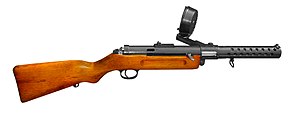 Bergmann MP 18 |
|
| Type | Submachine gun |
| Place of origin | |
| Service history | |
| In service | 1918–1945 (Germany) |
| Used by | see users |
| Wars | World War I Second Sino-Japanese War Chaco War Chinese Civil War World War II |
| Production history | |
| Designer | Hugo Schmeisser |
| Designed | 1916 |
| Manufacturer | Bergmann Waffenfabrik Qingdao Iron Works |
| Produced | 1918–1920s |
| Specifications | |
| Weight | 4.18 kg (9.2 lb) |
| Length | 832 mm (32.8 in) |
| Barrel length | 200 mm (7.9 in) |
| Cartridge | 9×19mm Parabellum 7.63×25mm Mauser |
| Action | open bolt blowback |
| Rate of fire | ~500 round/min |
| Muzzle velocity | 380 m/s (1,247 ft/s) |
| Feed system | 32 detachable drum magazine TM 08 (World War I); 20, 30 and 50 round detachable box (post-World War I) |
The firepower of this new class of weapons made such an impression on the Allies that the Treaty of Versailles specifically banned further study and manufacture of such light automatic firearms by Germany.[1]
Contents[hide] |
[edit] History
What became known as the "submachine gun" had its genesis in the early 20th Century and developed around the concepts of infiltration and fire and movement, specifically for the task of clearing trenches of enemy soldiers, an environment within which engagements were unlikely to occur beyond a range of a few feet.In 1915, the German Rifle Testing Commission at Spandau decided to develop a new weapon for trench warfare. An attempt to modify existing semi-automatic pistols, specifically the Luger and C96 Mauser failed, as accurate aimed fire in full automatic mode was impossible due to their light weight and high rate of fire of 1,200 rounds per minute. The Commission determined that a completely new kind of weapon was needed. Hugo Schmeisser, working for the Bergmann Waffenfabrik was part of a team composed of Theodor Bergmann and a few other technicians. They designed a new type of weapon to fulfill the requirements, which was designated the Maschinenpistole 18/I. It is not clear what the "I" designation is intended to indicate, although its successor, the MP28, was designated the Maschinenpistole 28/II.
Full scale production did not begin until early 1918.[2] Though technically not the world's first submachine gun, being beaten by the double-barreled Italian Villar-Perosa of 1915, in modern usage of the term the MP18 is considered the world's first submachine gun since the Villar Perosa had been designed to be used as a light machine gun on aircraft before it was adapted to infantry use as a single-barreled shoulder-fired weapon in late 1918.
[edit] Service history
| This section does not cite any references or sources. (June 2009) |
The MP18 proved to be an excellent weapon. Its concept was well proven in trench fights. Its basic design directly influenced later submachine gun designs and showed its superiority vs the regular infantry rifle in urban combat and mobile warfare as well as in guerrilla warfare. In 1919 during the German revolutionary period, MP 18 were used successfully in house to house fights to regain control of a city in Berlin and Munich in what was more police type counter insurgency than a military operation.
All the limited conflicts between 1920 and 1940 saw an increasing use of this new class of weapons, first in South America during the Chaco War, then in Europe during the Spanish Civil War, and in China during the Japanese invasion where its use by well trained Chinese troops was costly for the invaders as in the battle of Shanghai, where fierce street fights prefigured World War II urban combat of Stalingrad, Warsaw, Vienna and Berlin.
The MP18 continued in use with German police forces after the end of the war. It was widely used in combat by the Freikorps Von Epp against the Spartacus League in Bavaria and by some other Freikorps in Berlin where its efficiency in urban combat was demonstrated. Since the Treaty of Versailles prohibited the use and manufacture of pistols with a barrel over four inches (102 mm) and/or a magazine capacity over eight rounds, all Trommel Magazines TM 08 were destroyed.
Since the Treaty allowed the Weimar Republic to keep a small quantity of submachine guns for police use, a few hundred MP18.1 were modified to accept Schmeisser's original 20 round magazine design. This modification, conducted by Haenel Waffenfabrik, required removal of the existing magazine well collar, and replacement with a different one. These weapons were overstamped with the date "1920" on receiver and magazine well to show they were legitimate weapons owned by the Weimar Republic and not war bringbacks or clandestine weapons.
Bergmann sold the license of the MP18. 1 to SIG Switzerland; the Swiss made model was known as SIG Bergmann 1920. It existed in .30 Luger, 9mm Parabellum and 7.63 mm Mauser. The Bergmann MP18.1 represents a milestone both in terms of armament technology and warfare tactics. It opened the way for a whole new class of weapons and triggered the research for lighter automatic firearms to be used by mobile troops. Its first direct competitors did not see service in World War I, but most of them saw use in all the limited conflicts taking place in the inter-war period.
[edit] Evolution
The MP28 was produced by Haenel under the supervision of Hugo Schmeisser, it was copied by the Second Spanish Republic under the codename Naranjero. The Naranjero was chambered in 9mm Largo. [4]
The Austrian Steyr MP34 was created by a team of technicians led by Louis Stange who designed a submachine gun for Rheinmetall in 1919 and used Bergmann's MG15 to design the MG 30. The SIG Bergmann 1920 was used by Finland and Estonia, it was the inspiration for the Estonian Tallinn 1923 and the Finnish Suomi model 31, which in turn inspired Degtyarev for his PPD 34.
Emil Bergmann, Theodor Bergmann's son designed the MP32 that evolved into the MP34 as adopted by Denmark before to receive the MP35 name when adopted by nascent Wehrmacht in 1935. This SMG is often mistaken with the Mitraillette 34, a MP28 made in Belgium by Pieper Bayard, former Bergmann licensed manufacturer or with the MP34 made by Steyr. It is easy to identify the Bergmann MP 32/34/35 or its final version 35/1 since the cocking lever works exactly like a rifle bolt.
In 1940, with a pressing need for individual automatic weapons, the British copied the MP28 and developed the Lanchester submachine gun for the Royal Navy. Solidly built with the use of brass for the magazine well, and a bayonet mount, it entered service in 1940. The magazine and the bolt of the MP28 could be used in the Lanchester.
The OVP 1918, an offspring of Revelli's Villar Perosa 1915, inspired Heinrich Vollmer for his telescopic bolt used in the VPM 1930, EMP, MP38, MP40 and MP41. The MP18 remained in limited service with the German armed forces during the Second World War, specifically with the Sicherheitsdienst, later eastern foreign divisions of the Waffen SS and also with Kriegsmarine coastal artillery units.
[edit] Design details
| This section does not cite any references or sources. (June 2009) |
Though Schmeisser designed a conventional 20 round capacity "box" magazine for the weapon, the Testing Commission, for practical reasons, insisted that the MP18 be adapted to use the 32 round TM 08 Luger "snail" drum magazines that was widely used with the long barreled version of the P 08 pistol known as Artillery model.
The MP-18 design had a drawback common to all open-bolt designs: That of accidental discharge. If the buttstock of a loaded gun was given a hard knock while the bolt was fully forward, the gun could accidentally fire because of the bolt overcoming the action spring resistance and moving rearward enough to pick up a round, chamber it and fire. Soldiers liked to leave the bolt of their firearm in the closed or forward position so dirt and debris would not enter into the barrel and chamber. This 'Bolt-closure' practice acted as a dust cover for the weapons chamber, preventing a malfunction from occurring because of the presence of foreign debris.
The German police asked for an external safety on its MP18 and a universal bolt locking safety was added on all the submachine guns used by the police. Later sub-machine gun designs like the Sten or the MP40 were modified to allow the cocking handle to be pushed inwards to lock the closed bolt to the tubular receiver casing. This design change prevented accidental discharges when the bolt was left forward and a loaded magazine was inserted.
[edit] Operation
| This section does not cite any references or sources. (June 2009) |
After 1920, the MP18 was modified to use a straight magazine similar to those used in the later developed MP40 submachine gun. The MP18 could only fire in the fully automatic mode. Its successor, the MP28/2, received a modified mechanism with a selector for single shot or fully automatic fire.
Britain directly copied the MP28 at the beginning of World War II. The result was the Lanchester submachine gun, which saw service with the Royal Navy. The British Sten used the side-mounted magazine configuration and a simplified version of the open bolt firing operating system of the MP28.
Soviet Union made a similar use of MP 18 design in their PPD-40 sub machine gun in 1934. Further development of PPD-40 lead to simplified and mass-produced PPSh-41.
[edit] Users
Karabiner 98k
From Wikipedia, the free encyclopedia
| Karabiner 98 Kurz | |
|---|---|
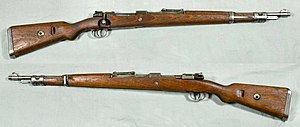 Karabiner 98k from the collections of Armémuseum, Stockholm, Sweden. |
|
| Type | Bolt-action rifle |
| Place of origin | |
| Service history | |
| In service | 1935–Present |
| Used by | See Users |
| Wars | Spanish Civil War, World War II, Second Sino-Japanese War, Korean War, First Indochina War, Chinese Civil War, Suez Crisis, Portuguese Colonial War, Algerian War, Greek Civil War, Vietnam War,[1] Six Day War, Yom Kippur War, Iran–Iraq War, Yugoslav wars,[1] Romanian Revolution, Iraq War, and current regional conflicts. |
| Production history | |
| Designed | 1935 |
| Manufacturer | Mauser (augmented by several other makers) |
| Produced | 1935–1945 |
| Number built | 14,643,260[2][3] |
| Variants | G40k |
| Specifications | |
| Weight | 3.7 kg (8.2 lb) - 4.1 kg (9.0 lb) |
| Length | 1,110 mm (43.70 in) |
| Barrel length | 600 mm (23.62 in) |
| Cartridge | 7.92×57mm Mauser |
| Action | Bolt-action |
| Muzzle velocity | 760 m/s (2,493 ft/s) |
| Effective range | 500 m (550 yd) with iron sights 800+ m (875+ yd) with telescopic sight |
| Feed system | 5-round stripper clip, internal magazine |
| Sights | Iron sights or telescopic sight. |
Contents[hide] |
[edit] History
The Karabiner 98k was derived from earlier rifles, namely the Mauser Standardmodell and the Karabiner 98b, which in turn had both been developed from the Gewehr 98. Since the Karabiner 98k rifle was shorter than the earlier Karabiner 98b (the 98b was a carbine in name only, a version of Gewehr 98 long rifle with upgraded sights), it was given the designation Karabiner 98 Kurz, meaning "Carbine 98 Short". Just like its predecessor, the rifle was noted for its reliability, great accuracy and an effective range of up to 500 metres (550 yd) with iron sights and 1,000 metres (1,090 yd) with an 8× telescopic sight.[4][edit] Design details
[edit] Features
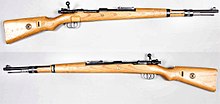
Karabiner 98k in mint condition, made in 1940. From the collections of Armémuseum, Stockholm, Sweden.
The metal parts of the rifle were blued, a process in which steel is partially protected against rust by a layer of magnetite (Fe3O4). Such a thin black oxide layer provides minimal protection against rust or corrosion, unless also treated with a water-displacing oil to reduce wetting and galvanic corrosion.
[edit] Sights
Originally the Karabiner 98k iron sight line had an open post type front sight, and a tangent-type rear sight with a V-shaped rear notch. From 1939 onwards the post front sight was hooded to reduce glare under unfavourable light conditions and add protection for the post. These standard sight lines consisted of somewhat coarse aiming elements making it suitable for rough field handling, aiming at distant area fire targets and low light usage, but less suitable for precise aiming at distant or small point targets. The rear tangent sight was graduated for 1935 pattern 7.92×57mm IS cartridges from 100 m to 2000 m in 100 m increments. These cartridges were loaded with 12.8 g (197 gr) sS (schweres Spitzgeschoß – "heavy pointed bullet") ball bullets.[edit] Stock
Most rifles had laminated stocks, the result of trials that had stretched through the 1930s. Plywood laminates are stronger and resisted warping better than the conventional one-piece patterns, did not require lengthy maturing, and were cheaper. The laminated stocks were somewhat heavier compared to one-piece stocks.[5] In addition to the use of Walnut and Beech laminate, Elm was used in small quantities. The butts of the semi-pistol grip Karabiner 98k stocks were not uniform. Until early 1940 the stocks had a flat buttplate. After 1940 some stocks had a cupped buttplate. Some stocks had a metal buttplate.[citation needed][edit] Accessories
When issued the Karabiner 98k came accompanied with assorted accessory items including a sling, a protective muzzle cover, and for field maintenance a Reinigungsgerät 34 (Cleaning Kit 34) or RG34 kit. Introduced in 1934 the Reinigungsgerät 34 consisted of a flat 85 mm (3.3 in) wide by 135 mm (5.3 in) long sheet metal container with 2 hinged lids carried on the person which held an oiler, a take down tool for removing the floorplate and cleaning the receiver of the rifle, an aluminum barrel pull-through chain, a cleaning and an oiling brush, and short lengths of tow used as cleaning patches.[6]The Karabiner 98k rifle was designed to be used with an S84/98 III bayonet.[7] The S84/98 III had a blade length of 252 mm (9.9 in) and an overall length of 385 mm (15.2 in) and was accompanied by a bayonet frog.[8] Older bayonet types designed for the Gewehr 98 could also be mounted and were used during World War II as well.[citation needed] Other accessories to fire rifle grenades or reduce the sound signature during firing were designed for the Karabiner 98k.
[edit] Rifle grenade launcher
[edit] Suppressor
A removable, muzzle-mounted HUB-23 suppressor, visually resembling the Schießbecher, was available for the Karabiner 98k. After several suppressor proposals from the firearms industry and the SS-Waffenakademie (SS Weapons Academy) the HUB-23 was produced based on a design proposal by Unteroffizier Schätzle. The HUB-23 weighs 0.5 kg (1.1 lb) and is 180 mm (7.1 in) long. The maximum effective range of a Karbiner 98k with a HUB-23 mounted and firing special subsonic Nahpatrone (Near cartridge) reduced load ammunition with a muzzle velocity of 220 m/s (722 ft/s) was 300 m (330 yd). The use of the HUB-23 suppressor and subsonic ammunition resulted in a sound signature reduction by 75%.[10] The HUB-23 suppressor and the special subsonic ammunition were mainly used by special forces units such as the Brandenburgers and snipers.[citation needed][edit] Variants
Several special models of the Karabiner 98k existed.[edit] Kriegsmodell
Starting in late 1944, Karabiner 98k production began transition to the "Kriegsmodell" ("war model") variant. This version was simplified to meet wartime production demands, removing the bayonet lug, cleaning rod, stock disc (which functions as a bolt disassembly tool), and other features deemed to be unnecessary.[11] At least two transitional variants existed, which incorporated only some Kriegsmodell features, and some factories never switched to Kriegsmodell production at all.[edit] Sniper variant
[edit] Paratroopers
For German paratroopers special versions of the Karabiner 98k that could be transported in shortened modes were produced. Experimental specimens with folding stocks (Klappschaft) and with detachable barrels (Abnehmbarer Lauf) are known to have been produced at Mauser Oberndorf.[14][edit] G40k
| This section may contain original research. (August 2012) |
A reverse engineering simulation with QuickLOAD internal ballistic software for the 8×57mm IS/7.92×57mm IS cartridge loaded with the German standard sS (schweres Spitzgeschoß/heavy pointed bullet) ball bullet, predicted that this shortening of the barrel results in ≈ 35 – 60 m/s muzzle velocity reduction depending on the propellant used. Due to its significant lighter weight the G40k produced ≈ 20% more recoil compared to the Karabiner 98k standard rifle.[citation needed]
[edit] German small arms doctrine
The Karabiner 98k had the same disadvantages as all other military rifles designed around the year 1900 in that it was comparatively bulky and heavy, having been created during a time when military doctrine centered around highly-trained marksmen engaging at relatively long range. The rate of fire was limited by how quickly the bolt could be operated. Its magazine had only half the capacity of Great Britain's Lee-Enfield series rifles, but being internal, it made the weapon more comfortable to carry at its point of balance. An experimental trench magazine was produced during World War II for Model 98 variants that could be attached to the bottom of the internal magazine by removing the floor plate, increasing capacity to 20 rounds, though it still required loading with 5 round stripper clips. While the Americans had standardized a semi-automatic rifle in 1936 (the M1 Garand), the Germans maintained these bolt-action rifles due to their tactical doctrine of basing a squad's firepower on the light machine gun so that the role of the rifleman was largely to carry ammunition and provide covering fire for the machine gunners. They did experiments with semi-automatic rifles throughout the war (the Gewehr 43/Karabiner 43 entered limited service), and introduced the first assault rifle in 1943 - the MP43 / MP44 / StG44 series. However, the Karabiner 98k remained the primary service weapon until the last days of the war, and was manufactured until the surrender in May 1945.In close combat, however, submachine guns were often preferred, especially for urban combat where the rifle's range and low rate of fire were not very useful, although the rifle's powerful ammunition was better able to penetrate walls and other cover found in urban areas. Towards the end of the war, it was intended to phase out the Karabiner 98k in favour of the StG44, which fired the 7.92×33mm Kurz intermediate rifle round that was more powerful than the pistol cartridges of submachine guns, but that could be used like a submachine gun in close-quarters and urban fighting. Production of the StG44 was never sufficient to meet demand, being a late-war weapon.
[edit] Usage history
[edit] Pre–World War II export

Swedish Gevär m/1940 in 8×63mm, with muzzle brake. From the collections
of Armémuseum, Stockholm,
Sweden.
[edit] World War II use

A concealed German soldier in northern France,
1944. His Karabiner 98k is equipped with a Gewehrgranatgerät cup-type
grenade launcher attachment.
[edit] Post–World War II use
[edit] Soviet Capture
During World War II, the Soviet Union captured millions of Mauser Karabiner 98k rifles and re-furbished them in various arms factories in the late 1940s and early 1950s. These rifles were originally stored in the event of future hostilities with the Western Bloc. These rifles, referred to by collectors as RC ("Russian Capture") Mausers, can be identified by a crude "X" stamp on the left side of the receiver, the dull, thick reblueing and mismatched parts and electro-pencil serial numbers on smaller parts. The Soviet arsenals made no effort to match the rifle's original parts by serial number when reassembling them, and some parts (the cleaning rod, sight hood, and locking screws) were deemed unnecessary and melted down for scrap metal.Most of these rifles (along with the Mosin-Nagant rifle) were eventually shipped to communist or Marxist revolutionary movements and nations around the world during the early Cold War period. A steady supply of free surplus military firearms was one way that Moscow could support these movements and states whilst retaining plausible deniability as well as give Moscow a means to arm these governments and movements without providing them the latest Soviet infantry weapons (these governments and movements Moscow supported would be provided modern infantry weapons like the SKS and the AK-47 at a later date).
One example of the Soviet Union providing the Mauser Karabiner 98k rifle (as well as other infantry weapons captured from the Germans during and after World War II) to its communist allies during the Cold War period occurred during the Vietnam War with the Soviet Union providing military aid to the armed forces of North Vietnam and to the NLF in South Vietnam.
A considerable number of Soviet-captured Mauser Karabiner 98k rifles (as well as a number of Karabiner 98k rifles that were left behind by the French after the First Indochina War) were found in the hands of NLF (Vietcong) guerrillas and VPA (NVA) soldiers by US, South Vietnamese, South Korean, Australian and New Zealand forces alongside Soviet-bloc rifles like the Mosin-Nagant, the SKS, and the AK-47.
[edit] Post-occupation service
In the years after World War II, a number of European nations on both sides of the Iron Curtain that were invaded and occupied by Nazi Germany used the Mauser Karabiner 98k rifle as their standard-issue infantry rifle, due to the large number of German weapons that were left behind by the Germans at the end of World War II.Nations like France and Norway used the Mauser Karabiner 98k rifle and a number of other German weapons in the years after World War II.

The emblem of Nazi Germany, eagle with swastika,
is still visible on many of the rifles that were used by the Norwegian
military. The "FLY" prefix to the serial number denotes that this rifle
was issued to the Flyvåpenet (Air Force).
Former German Karabiner 98k rifles were widely distributed throughout the Eastern Bloc, some being refurbished 2 or 3 times by different factories. They were used by military and para-military forces (such as the East German Combat Groups of the Working Class), and were replaced by Soviet weapons in the 1960s.

East
German members of the Combat Group of the Working
Class and Border Troops
at the border of the Berlin sector in 1961. The Combat Group members
are equipped with Karabiner 98k rifles.
The Yugoslavian arms producer Zastava Arms refurbished German Karabiner 98k rifles. These Prеduzeće 44 rifles are readily identifiable as the German factory code markings have been scrubbed from the receiver and replaced with the Yugoslav communist crest. The refurbished Prеduzeće 44 Karabiner 98k rifles were still being used in the Balkan wars of the 1990s.
[edit] Post–World War II derivatives
Many of the liberated European countries continued production of rifles similar to the Karabiner 98k, for example Fabrique Nationale (FN) in Belgium and Česká Zbrojovka (CZ) in Czechoslovakia produced both their proprietary older models and brand new Karabiner 98k rifles, many of which were assembled from leftover German parts or using captured machinery.As with post-Nazi occupation service post-war production of derivatives was a stop-gap solution until enough numbers of more modern automatic rifles could be developed and produced. The vast majority of the 98K pattern rifles were soon stored as reserve weapons or given for very low prices to various fledgling states or rebel movements throughout the developing world.
Both FN and CZ utilized a modified Kriegsmodell design, with the cleaning rod and stock disk still omitted, but the bayonet lug restored. In Czechoslovakia it was known as P-18 or puška vz.98N, the first being the manufacturer's cover designation of the type, the second official army designation - rifle model 98, N for německá - German. In Romania, the Czechoslovak version was known under the informal name of ZB, after Zbrojovka Brno - the Czechoslovak state producer of small weapons and munitions - and it was used to arm Romania's Patriotic Guards.
[edit] Yugoslavian M48
From 1950 to 1965, Yugoslavian Zastava Arms produced a near-copy of the Karabiner 98k imported between the wars from Fabrique Nationale called the Model 1948, which differed from the German rifle in that it had the shorter bolt-action of the Yugoslav M1924 series of rifles (not to be confused with the widely-distributed Czech Vz 24 which had a standard length action), a stronger barrel (Yugoslavia had low chromium deposits, so they could not produce steel as hardened as Krupp- or Sweden-steel used in other variants, and made up for it in material strength), and a rear sight enclosed in the wooden hand guard (the German-style hand guard began in front of the rear sight, unlike e.g. exports to South America that had a hand guard and rear sight like the M48).[edit] Spanish M43
The Spanish M43, produced in La Coruña until 1957,[citation needed] was a variant of the 98k with a straight bolt handle, a front sight guard and a handle groove in the front stock much like the earlier Reichspostgewehr. It was chambered in 7.92×57mm Mauser calibre. When Spain began switching to the CETME automatic rifle, many M43 were converted to FR8 rifles for military training purposes and Guardia Civil service.[edit] Israeli Mauser
A number of non-European nations used the Mauser Karabiner 98k rifle as well as a few guerrilla organizations to help establish new nation-states. One example was Israel who used the Mauser Karabiner 98k rifle from the late 1940s until the 1970s.The use of the Karabiner 98k to establish the nation-state of Israel often raises a lot of interest among people and rifle collectors today. Many Jewish organizations in Palestine acquired them from post–World War II Europe to protect various Jewish settlements from Arab attack as well as to carry out guerrilla operations against British Army forces in Palestine.
The Haganah, which later evolved into the modern-day Israel Defense Forces, was one of the Jewish armed groups in Palestine that brought large numbers of Mauser Karabiner 98k rifles and other surplus arms (namely the British Lee-Enfield bolt-action rifle, which was used on a large scale by these groups and the Mosin-Nagant) from Europe during the post–World War II period. Many, though not all, Israeli-used German surplus Mauser Karabiner 98k rifles have had all of the Nazi Waffenamt markings and emblems defaced with over stamped Israel Defense Force (IDF) and Hebrew markings as part of an effort to ideologically "purify" the rifles from their former use as an infantry weapon of Nazi Germany.
As the Arab-Israeli conflict approached, the Haganah and other Jewish forces in Palestine tried to get hold of as many weapons as they could in the face of an arms embargo by British colonial authorities. One of most important purchases was a secret January 14, 1948, $12,280,000 worth contract with Czechoslovak Government including 4,500 P-18 rifles, as well as 50,400,000 rounds of ammunition. Later, the newly established Israel Defense Force ordered more numbers of Mauser Karabiner 98k rifles, produced this time by Fabrique Nationale. These have Israeli and Belgian markings on the rifle as well as the emblem of the IDF on the top of the rifle's receiver. The FN-made Karabiner 98k rifles with the IDF markings and emblem on the rifle were produced and sold "legally" to Israel after it established itself as an independent nation in 1948. At some point, Israel converted all other Mauser 98-based rifles in their inventory (most commonly Czechoslovak vz. 24 rifles, but small numbers of contract Mausers from sources ranging from Ethiopia to Mexico were also known to have come into Israeli hands) to the now standardized Karabiner 98k configuration. The original receiver markings of these conversions were not altered, making it easy for collectors to identify their origin. The Israeli Karabiner 98k utilized the same bayonet design as in German service, with a barrel ring added. The Israeli bayonets were a mix of converted German production and domestically produced examples.
During the late 1950s, the IDF converted the calibre of their Mauser Karabiner 98k rifles from the original German 7.92 mm round to 7.62 mm NATO following the adoption of the FN FAL rifle as their primary rifle in 1958. The Israeli Mauser Karabiner 98k rifles that were converted have "7.62" engraved on the rifle receiver. Rifles with original German stocks have "7.62" burned into the heel of the rifle stock for identification and to separate the 7.62 NATO rifles from the original 7.92 mm versions of the weapon still in service or held in reserve. Some Karabiner 98k rifles were fitted with new, unnumbered beech stocks of recent manufacture, while others retained their original furniture. All of these converted rifles were proof-fired for service.
The Karabiner 98k rifle was used by the reserve branches of the IDF well into the 1960s and 1970s and saw action in the hands of various support and line-of-communications troops during the 1967 Six-Day War and the 1973 Arab-Israeli War. After the rifle was retired from reserve military service, the Israeli Mauser Karabiner 98k was given to a number of Third World nations as military aid by the Israelis during the 1970s and 1980s, and sold as ex-military surplus on the open market, with many Israeli Mausers being exported to Australia (the Israeli Mauser is the most predominant variant of the Mauser Kar98k rifle on the Australian surplus firearms market today) and the United States during the 1970s and 1980s. The Israeli Mausers provided to Third World armies began to themselves be imported for civilian sale in the United States, and tend to be in significantly worse condition than those sold directly out of Israeli storage.
[edit] Contemporary use
During the 1990s, the Yugoslavian Karabiner 98k rifles and the Yugoslavian M48 and M48A rifles were used alongside modern automatic and semi-automatic rifles by all the warring factions of the Yugoslav wars. There are a number of photographs taken during the war in Bosnia, showing combatants and snipers using Yugoslavian-made Mauser rifles from high-rise buildings in the Bosnian city of Sarajevo.[23]
The Norwegian Army currently (2008) use the Våpensmia NM149 and NM149-F1 sniper rifles which are based on Karabiner 98k bolt actions. Besides Mauser M 98 system actions, captured by Norway at the end of World War II in 1945, contemporary components originating from several manufacturers are used by Våpensmia A/S to build the NM149 and NM149-F1.
The Karabiner 98k is still used by San Marino's Guardia di Rocca.[citation needed]
Since 2003, the Mauser Karabiner 98k rifle (along with the Mosin-Nagant, the Lee-Enfield and the Yugoslavian M48) has been encountered in Iraq by US and Allied forces with Iraqi insurgents making use of the Karabiner 98k and other bolt-action rifles alongside more modern infantry weapons like the AK series rifles and the SKS carbine. The extra range afforded by the 7.92×57mm IS cartridge still makes it a viable low-cost marksmen rifle for the insurgents.
Many Third World nations still have Karabiner 98k rifles in their arsenals and it will most likely be encountered in regional conflicts for many years to come.
[edit] Civil use
The Karabiner 98k rifles that were used by Germany during World War II are highly sought after collector's items in many circles. The Mauser Karabiner 98k rifle remains popular among many rifle shooters and military rifle collectors due to the rifle's historical background, as well as the availability of both new and surplus 7.92×57mm IS ammunition. As of 2010[update], the Mauser Karabiner 98k rifles that were captured by the Soviets during World War II and refurbished during the late 1940s and early 1950s have appeared in large numbers on the military surplus rifle market. These have proven popular with buyers in the United States and Canada, ranging from ex-military rifle collectors to target shooters and survivalists, due to the unique history behind the Soviet capture of Mauser Karabiner 98k rifles.The widespread availability of surplus Mauser 98k rifles and the fact that these rifles could, with relative ease, be adapted for hunting and other sport purposes made the Mauser 98k popular amongst civilian riflemen. When German hunters after World War II were allowed again to own and hunt with full bore rifles they generally started to "rearm" themselves with the then abundant and cheap former Wehrmacht service rifles. Civilian users changed these service rifles often quite extensively by mounting telescopic sights, aftermarket hunting stocks, aftermarket triggers and other accessories and changing the original military chambering. Gunsmiths rebarreled or rechambered Mauser 98K rifles for European and American sporting chamberings such as the 6.5×55mm Swedish Mauser, 7×57mm Mauser, 7×64mm, .270 Winchester, .308 Winchester, .30-06 Springfield, 8×60mm S, 8×64mm S, etc. The magnum hunting cartridges 6.5×68mm, 8×68mm S and 9.3×64mm Brenneke were even specially developed by German gunsmiths for the standard military Mauser 98 action.
[edit] Modern civilian offspring
The Mauser-type action is widely held to be the pinnacle of bolt-action rifle design, and the vast majority of modern weapons of this type, both military and civilian, are still based on it to this day. The safety offered by its three-lug bolt and the added reliability of controlled feed (especially favored by dangerous game hunters) are considerable refinements not found in other designs.Throughout the design's history, standard sized and enlarged versions of the Mauser M 98 system have been produced for the civil market.
John Rigby & Co. commissioned Mauser to develop the M 98 magnum action over a hundred years ago. It was designed to function with the large sized cartridges normally used to hunt Big Five game and other dangerous game species. For this specialized type of hunting, where absolute reliability of the rifle under adverse conditions is very important, the controlled-feed M 98 system remains the standard by which other action designs are judged.[24]
Zastava Arms currently (2010) manufactures the M48/63 sporting rifle which is a short barreled variant of the Model 1948 military rifle and the Zastava M07 sniper rifle.[25][26]
Since 1999 the production of Mauser M 98 and M 98 Magnum rifles has been resumed in Germany by Mauser Jagdwaffen GmbH[27] (Mauser Huntingweapons Ltd.) according to original drawings of 1936 and the respective Mauser patents.
[edit] Users
 People's
Republic of China[28]
People's
Republic of China[28] Republic of
China[29]
Republic of
China[29] Croatia[1]
Croatia[1] Czechoslovakia (post 1945)[28]
Czechoslovakia (post 1945)[28] Denmark[28]
Denmark[28] East
Germany[28]
East
Germany[28] Finland:
Bought from Germans. Mainly used with the rifle grenade launcher
attached[citation needed]
Finland:
Bought from Germans. Mainly used with the rifle grenade launcher
attached[citation needed] France[28]
France[28] Germany[28]
Germany[28] Indonesia[30]:
The Indonesian National Military (TNI) used K 98k in Indonesian
National Revolution and obtained the rifles captured from Dutch forces.
Indonesia[30]:
The Indonesian National Military (TNI) used K 98k in Indonesian
National Revolution and obtained the rifles captured from Dutch forces. Israel[28]
Israel[28] Luxembourg:
The Grand Ducal Guard used captured German
K98k's in 1945, later replaced by Ross
rifles in the same year.[31]
Luxembourg:
The Grand Ducal Guard used captured German
K98k's in 1945, later replaced by Ross
rifles in the same year.[31] Nazi
Germany[32]
Nazi
Germany[32] Norway[33]
Norway[33] Netherlands:
Post WWII use.[citation needed]
Netherlands:
Post WWII use.[citation needed] Portugal[34]
Portugal[34] San
Marino: still used by the Guardia di Rocca.
San
Marino: still used by the Guardia di Rocca. Serbia[1]
Serbia[1] Slovakia[35]
Slovakia[35] Sweden:
Imported 5,000 Kar 98k rifles in 1939.[36]
Sweden:
Imported 5,000 Kar 98k rifles in 1939.[36] Turkey[30]
Turkey[30] Yugoslavia[28]
Yugoslavia[28] Pakistan
(post 1945)
Pakistan
(post 1945) Ethiopia:
Abyssinian patriots used captured K98k's against occupying Axis forces from 1941-onwards.[37]
Ethiopia:
Abyssinian patriots used captured K98k's against occupying Axis forces from 1941-onwards.[37]
[edit] Non-state actors
- Korean Liberation Army (a group that fought for the independence of Korea during the Japanese colonization period (1910–1945)).[28]





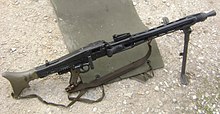


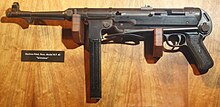
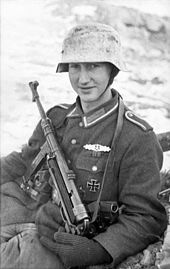


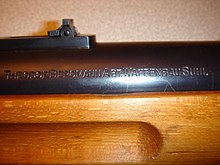

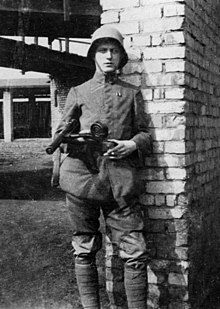
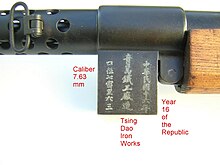







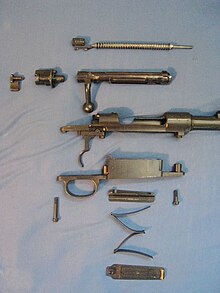
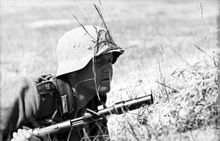


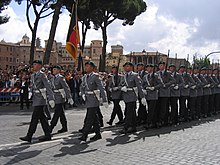



Tidak ada komentar:
Posting Komentar